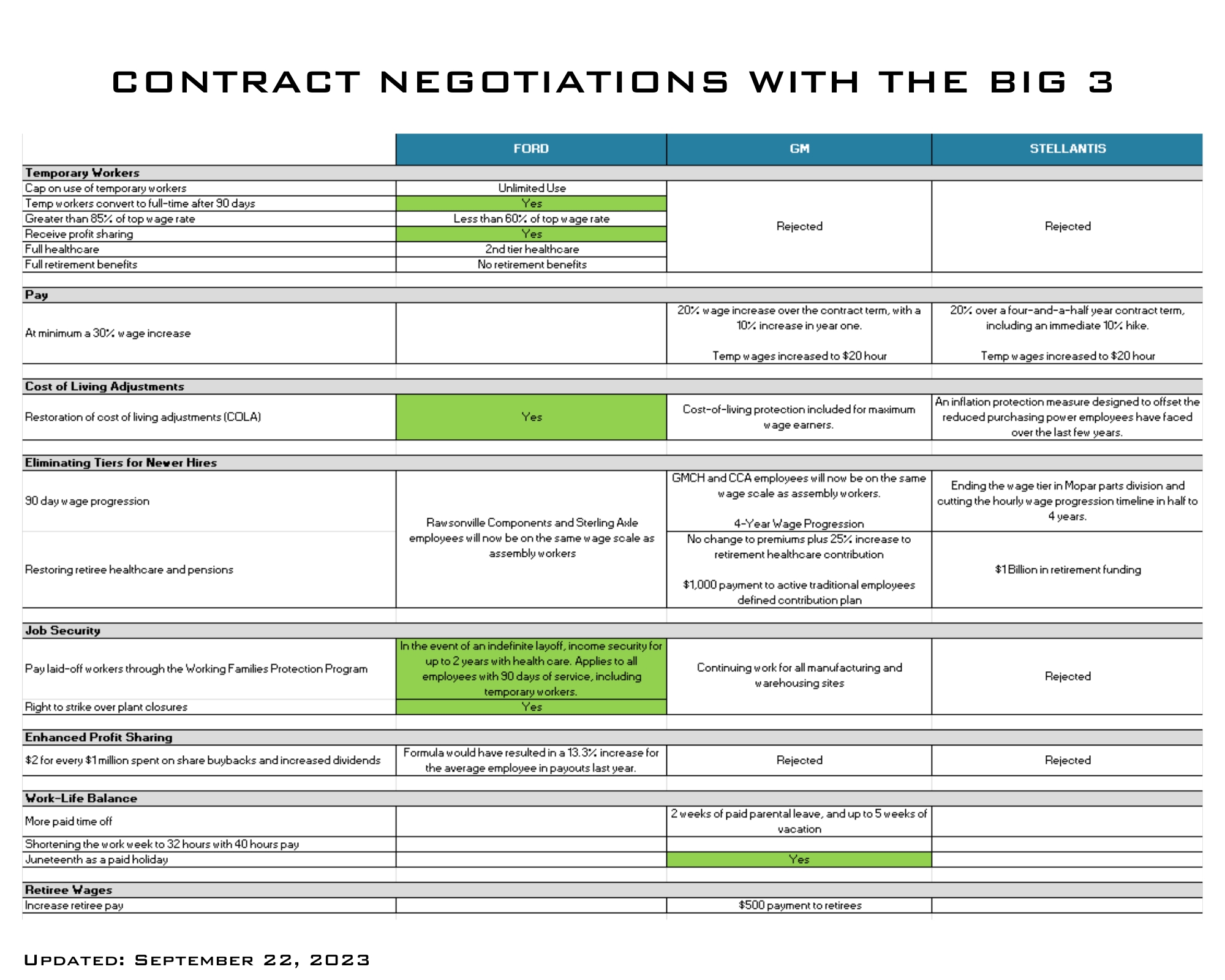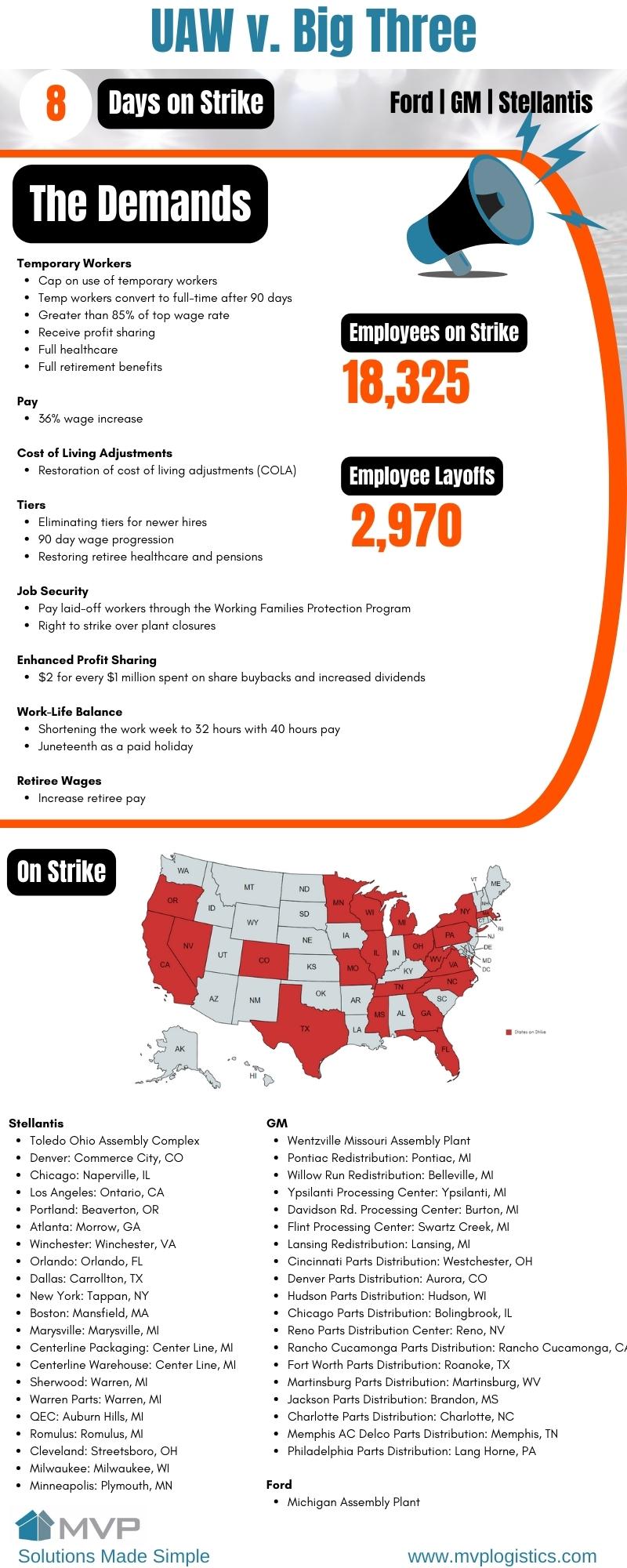What is the Goal of the UAW’s Stand-Up Strike
The United Auto Workers (UAW) have taken a stance against Ford, GM, and Stellantis, collectively known as the Big Three. They have created a movement called “Stand Up Strike.”
Harnessing the power of unity, the Stand-Up Strike strategy empowers individuals to create a monumental force. Rather than starting with a grand gesture, this method focuses on small actions that gain momentum over time. The UAW sees this as a defining event for their generation, vowing not to back down.
The original intention was not to resort to striking, but rather to negotiate a fair contract. Unfortunately, their efforts have not been met with enthusiasm from the Big Three. As a result, they have been forced to file unfair labor practices (ULPs) against GM and Stellantis with the National Labor Relations Board.
Departing from traditional approaches, the Stand-Up Strike introduces a fresh way of striking. Rather than a simultaneous shutdown of all plants, selected locals are called upon to “Stand Up” and go on strike.
As the movement gains momentum, more locals may join the strike, providing maximum leverage against the Big Three automakers. Locals not called upon to join the Stand-Up Strike will continue working without a contract extension.
With the Stand-Up Strike, unions have the freedom to take their efforts to a whole new level – a national, all-out work stoppage. This strategic approach keeps companies on their toes and gradually strengthens the unions’ economic leverage against the Big Three if they choose to ignore contract negotiations.
Goldman Sachs estimates the Big Three are losing $100 – $125 million weekly in revenue due to strikes.
Impending UAW Strike and Potential Impacts
Over the past four years, the profits of the Big Three automakers have shot up, reporting an increase of over 65%. The companies saw an increase of 6% in worker wages and a 40% increase in executive pay. The Big Three saw a 1,500% increase in stock buybacks in the last four years.
As the auto industry battles economic turbulence and labor unrest, it now faces another formidable challenge – skyrocketing car prices. With a 34% surge in recent times, this inflation is driven by rising manufacturing expenses and the integration of advanced technologies. This escalation isn’t just a hiccup for buyers; it’s turning new cars into luxury items. If these costs continue to accelerate, we may well see a dip in demand, further clouding the industry’s outlook.
The Members’ Demands: A Call for Equity and Fair Compensation
The UAW members’ call to action is resonantly clear, focusing on the eradication of second-tier employee statuses, considerable salary enhancements, and the reincorporation of Cost of Living Adjustments (COLA). Their demands include the implementation of defined benefit pensions for all staff and the re-initiation of retirees’ medical benefits.
These propositions echo the intensifying discontent among the workforce, stemming from their pursuit for a fair share of the industry’s wealth. More importantly, it’s a plea for acknowledgment of their critical contribution to the companies’ triumphs.
Another key demand is the right to protest against factory shutdowns, given the closure of 65 facilities by the Big Three in the last two decades, leaving deep scars on the workers and their communities. They also proposed a Working Family Protection Program, aimed at ensuring job security for UAW members; if relocation happens, companies ought to compensate workers for community service work.
The demands extend to putting an end to the exploitation of temporary workers, granting more leisure time for employees to be with their families, and a marked rise in retirees’ compensation. As Fain underscored, “Our battle at the Big Three reaches beyond us—it’s a fight for every worker’s rights and dignity.”

Impact on the Auto Industry and Companies with Union Workers
The 2019 General Motors (GM) walkout serves as a pertinent example of the financial toll a strike can exact on a company. The protest, which lasted 40 days, reportedly resulted in a loss of $3.6 billion for GM. This strike not only disrupted the company’s production schedule but also dealt a significant blow to its financial health. The impact was felt far beyond the company’s balance sheet, affecting relationships with suppliers and denting consumer confidence.
Reverting back to the annals of history, the UAW strike in 1936, considered one of the most influential labor protests in American history, lasted for 44 days. The significance of this strike was immense—it led to the formation of the United Auto Workers Union. The workers’ tenacity and resilience during this period of strife resulted in a more equitable work environment and became a pivotal moment in the labor rights movement. This strike epitomizes the power that workers can wield when they unite for a common cause.
The Consequences of a Stalled Heartbeat in the Automotive Sector
When the pulse of the automotive industry – its dedicated workforce – ceases to beat, the entire sector feels the tremor. In essence, the industry’s survival is inextricably tied to the wellbeing of its workers. If this life force is neglected, it can trigger a series of catastrophic events, from spiraling production costs to plummeting consumer confidence, that can cripple the health of the industry. Thus, the impeding UAW strike stands as a stark reminder of the potentially devastating consequences when the heartbeat of the automotive industry stops. Ignoring workers’ demands and grievances is akin to stopping the industry’s heartbeat, which could lead to irreversible damage and even the industry’s demise.
Picture the tool and die sector in the automotive industry – the Tier II and Tier III suppliers. These are the unsung heroes, the smaller businesses that diligently keep the wheels of the industry turning, often against the odds. They are the David standing firm against the Goliath of financial constraints, persisting despite their struggle to secure the lifeline of loans that keep their operations buoyant.
Now, imagine a UAW strike. Imagine the heart-stopping moment when work grinds to a halt, when the stoppage of production upstream plunges these businesses into a chilling silence – a silence that could spell disaster. This isn’t just a disruption to revenue; it’s a potential death knell. The financial losses could become an avalanche, threatening to sweep away these vital cogs in the industry.
The unsettling reality is that this could lead to a significant number of these companies being forced to close their doors forever, triggering a domino effect of job losses and a contraction in the industry.
This isn’t a faceless scenario. It’s a story about real businesses and real people. It’s about the potential loss of livelihoods and the erosion of an industry. And it underscores the urgency of finding an effective strategy to navigate these stormy waters.

How Tool and Die, Automotive Part Distributors, and Repair Shops Can Brace Themselves for the Impending Strike
To mitigate the potential impact of a UAW strike, tool and die manufacturers, automotive part distributors, and repair shops can deploy several strategies.
First, diversifying their supplier base can insulate these businesses from a complete halt in production. By sourcing components from a range of suppliers, they can reduce their dependency on a single source and ensure continuity of supply, even during industrial action.
Second, investing in inventory management can be a lifeline in times of supply chain disruption. A robust inventory system can enable businesses to monitor stock levels in real time, forecast demand, and plan accordingly to avoid stockouts or excess inventory.
MVP Logistics’ advanced inventory management systems provide real-time tracking of supplies, enabling businesses to anticipate potential shortfalls and respond expediently to avoid production halts. This system allows for precise forecasting and efficient planning, essential during periods of uncertainty.
Third, considering alternative manufacturing methods, such as outsourcing or offshoring, could provide a safety net. While this might involve upfront costs and potential quality control challenges, it could be a viable short-term solution to maintain production outputs.
Finally, establishing a contingency fund can provide financial resilience. This fund can be used to absorb unexpected costs, such as higher prices from alternative suppliers or additional freight charges due to last-minute orders.
These strategies, while requiring careful planning and potentially significant investment, could be the difference between survival and closure in an industry facing the prospect of a serious strike.
How to Manage Costs During the Strike
Managing costs during a strike is a delicate balancing act, but with strategic planning, businesses can navigate through uncertain times. Here are a few strategies to consider during a strike:
- Cost optimization: Businesses should review their operational costs and identify areas where expenses can be minimized without compromising business operations. This could include reducing unnecessary overheads, streamlining processes, or reassessing the necessity of certain roles or departments.
- Negotiate with suppliers: It could be beneficial to negotiate terms with existing suppliers for extended payment terms or discounts during the period of the strike. This would help maintain cash flow and reduce financial pressure.
- Evaluate product lines: Use this time to evaluate which product lines are truly profitable. If certain products are underperforming, it may be more cost-effective to discontinue them temporarily or permanently.
- Control Inventory: Effective inventory management can avoid overstocking items and tying up capital. Also, businesses should prioritize products that have higher turnover rates to maximize profitability.
- Explore Alternate Revenue Streams: If possible, businesses should consider exploring secondary revenue streams that are not affected by the strike. This could provide a much-needed cash injection during difficult periods.
- Lean on Technology: Technology can be a cost-effective way of streamlining operations. Automating routine tasks can reduce labor costs and increase efficiency.
How Can Auto Companies Continue to Succeed After the Strike is Over
As the dust settles post-strike, automotive companies should take the opportunity to reflect, learn, and evolve.
- Invest in People: First and foremost, companies must recognize the invaluable role their employees play. Investing in staff training, fair compensation, and fostering a positive work environment can boost morale, productivity, and reduce the likelihood of future labor disputes.
- Strengthen Supply Chain Resilience: The strike will have highlighted vulnerabilities within the supply chain. Companies should use this to fortify their supply chains, diversifying suppliers and integrating technology to improve visibility and responsiveness.
- Embrace Innovation: Rapid technological advancement provides an opportunity for companies to innovate both in their product offerings and operational processes.
- Focused and Effective Cost Management: Post-strike, it’s crucial to continue the cost management strategies implemented during the strike, focusing on operational efficiency and effective management of resources.
The road ahead may be challenging but with a forward-thinking approach and a commitment to continuous improvement, auto companies can navigate their way to long-term success.
MVP Logistics, one of the fastest-growing private companies in America as per our 2023 Inc. 5000 ranking, is here to provide support and assurance during this challenging time.
Whether you need temporary warehousing for your products, an alternative freight transport option to reduce freight costs, or a distributor for your parts, MVP Logistics has you covered. Our commitment to superior customer service and cost savings through consolidation and efficient routing sets us apart from other providers.
With MVP Logistics, you can take advantage of valuable cost-saving opportunities while ensuring your business operations continue smoothly. We are not just a logistic provider; we are your partner in growth, offering competitive rates and unparalleled customer service every step of the way. When it comes to meeting your freight shipping needs, choose the provider that has proven its expertise and reliability time and time again – choose MVP Logistics.
